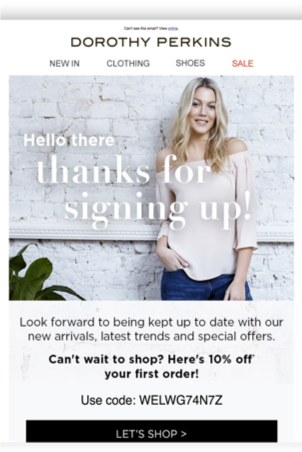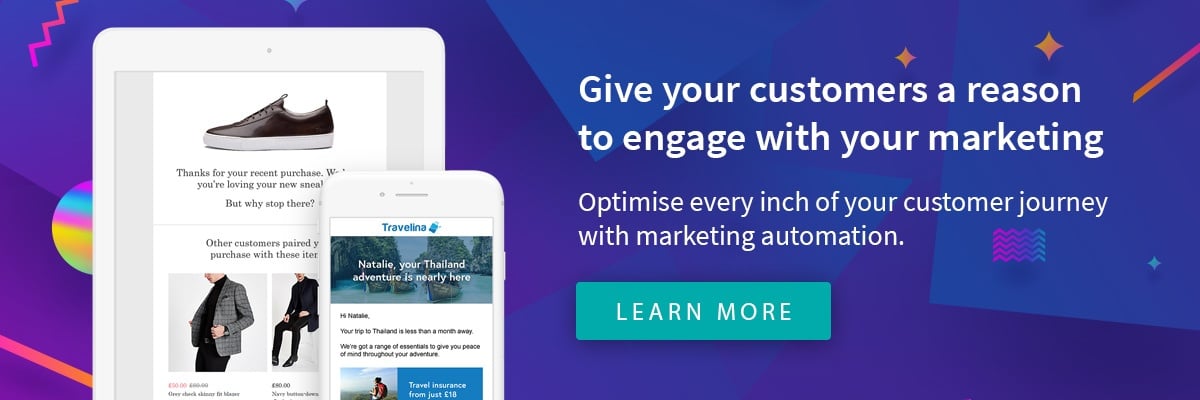Email frequently outperforms other channels. And not by a small margin. McKinsey tells us email is 40 times more effective at acquiring new customers than Facebook or Twitter.
Marketing automation enables brands to gain a competitive edge using email, automatically. Automated email campaigns free marketers from repetitive tasks, helping brands boost their bottom line. But which automated email campaigns should savvy marketers be sending?
In this blog post, we give you fifteen automated email campaign ideas to kick-start your brand’s email automation strategy.
1) Welcome campaign
A welcome campaign is a series of emails that introduce your brand to new email subscribers. These automated emails are triggered when someone new subscribes to your email list.
Your welcome campaign is an opportunity to tell your brand’s story in bite sized chunks. Done well, this series can move your customer through from initial interest to intention to buy, encouraging them to make their first purchase with you.
Here’s an example of a welcome campaign we love from Dorothy Perkins.

2) Thank you email
If your welcome campaign has done the job well, your subscriber has now made their first purchase. They are officially a customer!
But don’t rest on your laurels, use this opportunity to build rapport. You can strengthen your new customer’s bond to your brand with a thank you email.
A thank you email is a great way to celebrate a customer’s purchase and combat buyer’s remorse. Being thanked and congratulated goes a long way to reassuring your customer that they made the right choice.
3) How to guides
Not all your email automations need to be transactional. After a customer has bought from you send them a “how to” guide.
This useful content is an important way to deepen the post-purchase relationship with your customers. Showing a customer how to their purchase helps them get the most from it, cultivating positive brand sentiment.
Like thank you emails, “how to” guides help combat buyer’s remorse. They do so by reducing the risk your customers will get frustrated by not knowing how something works.
Here’s an example of a “how to” shoe care guide from Shuperb.

4) Arrival
Your customer placed an order a few days ago and today’s the day they should have received it.
Setting up an automated arrival email to be sent out on the day of delivery is an opportunity to check your customer received their purchase. This shows them that you care and helps to build rapport.
Arrival emails also enable you to catch any delivery problems early. This way you can resolve them for your customer before they decide to make a complaint.
5) Feedback
Once your customers have received their purchase and had an opportunity to test it out, ask them for their feedback.
Automated feedback emails are a great way to strengthen the relationship with your customer and improve your product offerings.
People like to know that you care what they think about their purchase. And what they tell you empowers you to make the changes your customers want.
Artifact Uprising asks for feedback well in this example:

6) Product recommendation
Product recommendations are a strong tool to cross-sell and upsell to your new customers.
Marketing automation technology allows you to curate recommendations based on past purchases or crowd source best sellers.
Whichever way you decide to curate them, sending a tempting selection of recommendations, automatically, is an effective way to entice customers back to by.
7) Related product discount
If product recommendations alone haven’t resulted in a repeat purchase, set up an email automation to send customers a related product discount to sweeten the deal.
8) Browse abandonment
Sometimes customers get distracted when they’re browsing products and leave without putting anything in their basket.
Sending browse abandonment emails helps you bring them back to your site, automatically.
Showing them items they were browsing, alongside related products, encourages them to continue their eCommerce journey with you.
9) Basket abandonment
Like browse abandonment campaigns, basket abandonment email automations entice customers back to buy.
Offering a small discount on what they had in their basket is an effective way of recovering revenue you may otherwise have lost.
Here’s a basket abandonment email from Levis that won us over:

10) VIP offer
Send exclusive offers to your highest value customers using email automations.
VIP offer emails are a clever way to capitalise on those who tend to spend most. It shows them they’re valued and encourages them to spend even more.
11) Sale countdown
Countdown timers are an innovative way to create a sense of urgency in your emails.
As countdown timers are animated, they’re super eye-catching. And there’s nothing like a ticking clock to get people to snap into action.
So, if you have a sale on, send an automated sale countdown campaign to get people excited to buy today.
This example of a sale countdown email is from Mothercare:

12) Refer a friend
If you’re looking to acquire new customers (let’s face it, who isn’t?), ask loyal customers to refer a friend.
Setting up a refer a friend email automation helps you build your customer base, automatically.
What’s more, asking for referrals builds rapport with your existing customers. Think of it like a close friend leaning in and asking for a favour. Giving and receiving favours makes relationships stronger.
13) Loyalty scheme
Smart marketers realise retaining customers makes business sense. Attracting new customers is five to twenty-five times more expensive than retaining existing ones.
Added to this, retained customers are worth more to your business than new ones. Increasing customer retention rates by just 5 percent increases profits by 25 to 95 percent.
Promoting a loyalty scheme through a series of automated emails is tried-and-tested customer retention tactic. Sell the benefits of your scheme to entice customers to join.
We love this example from JC Penney:

14) Replenishment email
If you sell products that run out, replenishment emails are a no-brainer.
These email automations make it easy for customers to buy from you again, before their product runs out. This makes them less likely to stray to a competitor.
15) Re-engagement email
However hard you try to keep in touch, it’s inevitable that some customers go quiet on you.
Re-engagement email automations are your tool to wake up those sleeping subscribers. Remind them what they’re missing, tempt them with a discount, or ask them if they’d like to receive different content to hook them back in.
Takeaway
We hope our fifteen essential automated email campaigns have given you plenty of ideas and inspiration to get you started.
All you need now is the right marketing automation technology to power your campaigns. That’s where we come in. To see our technology in action, click the button below.

